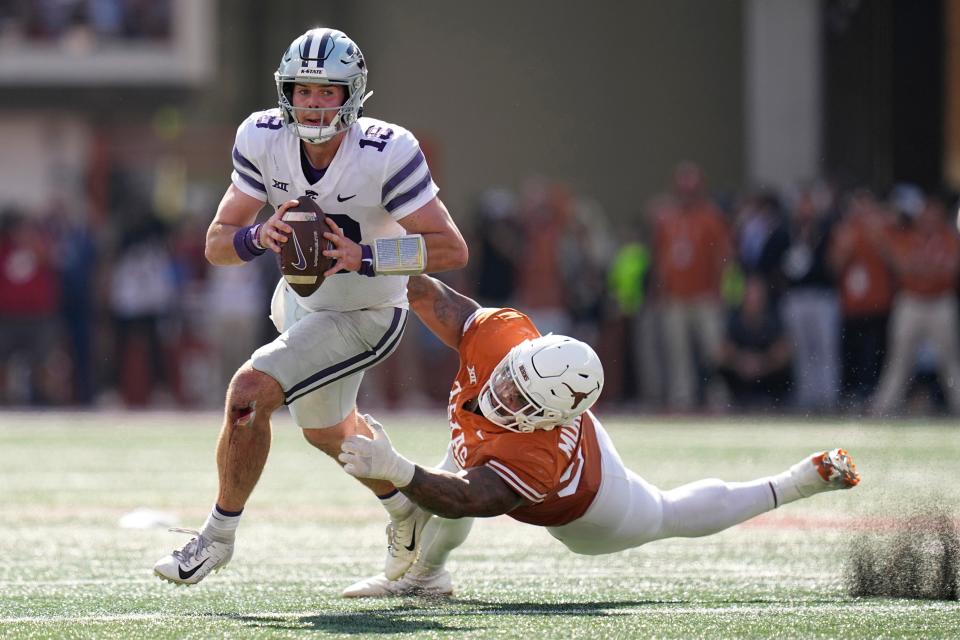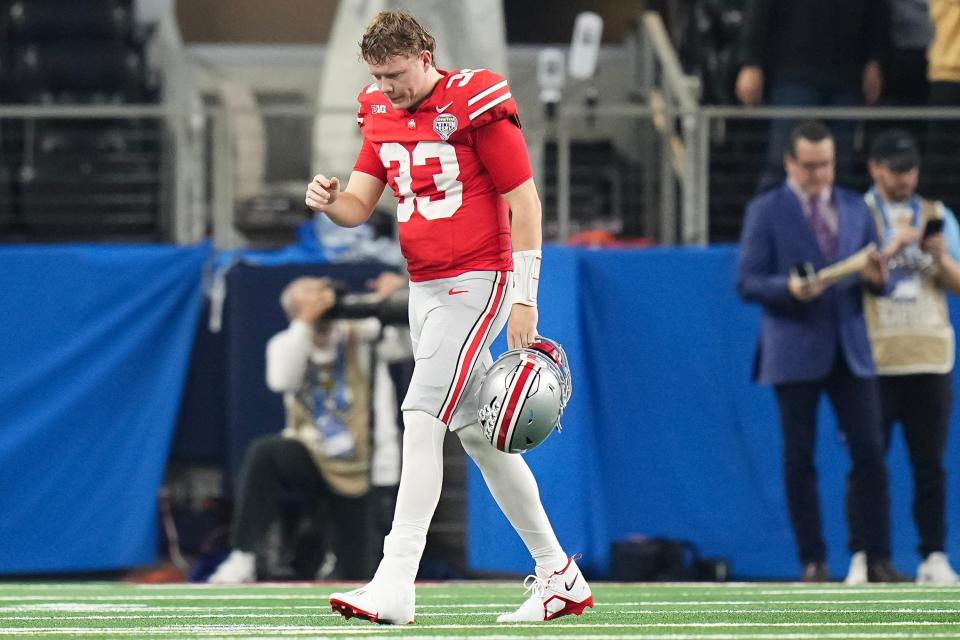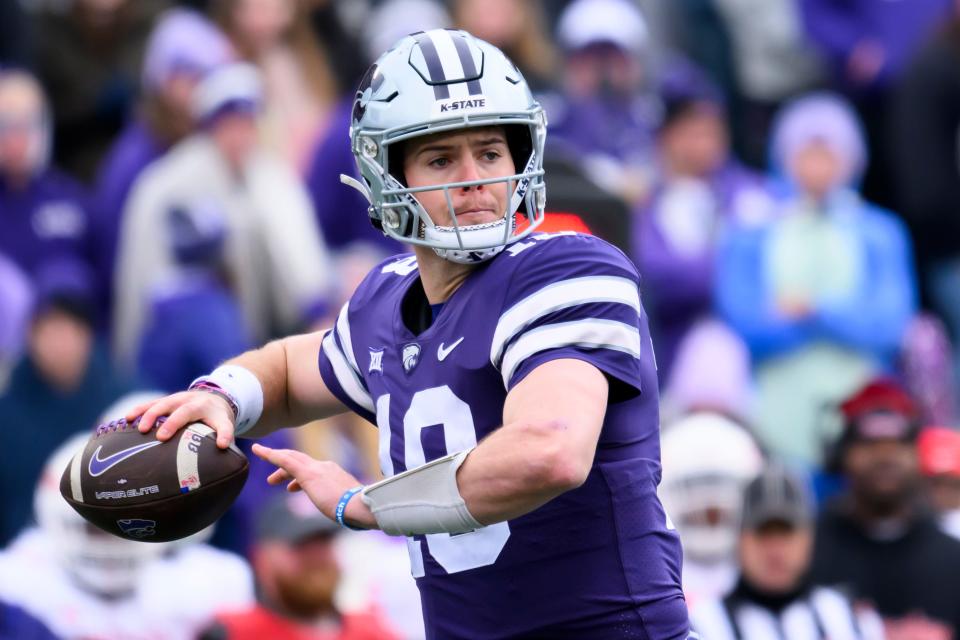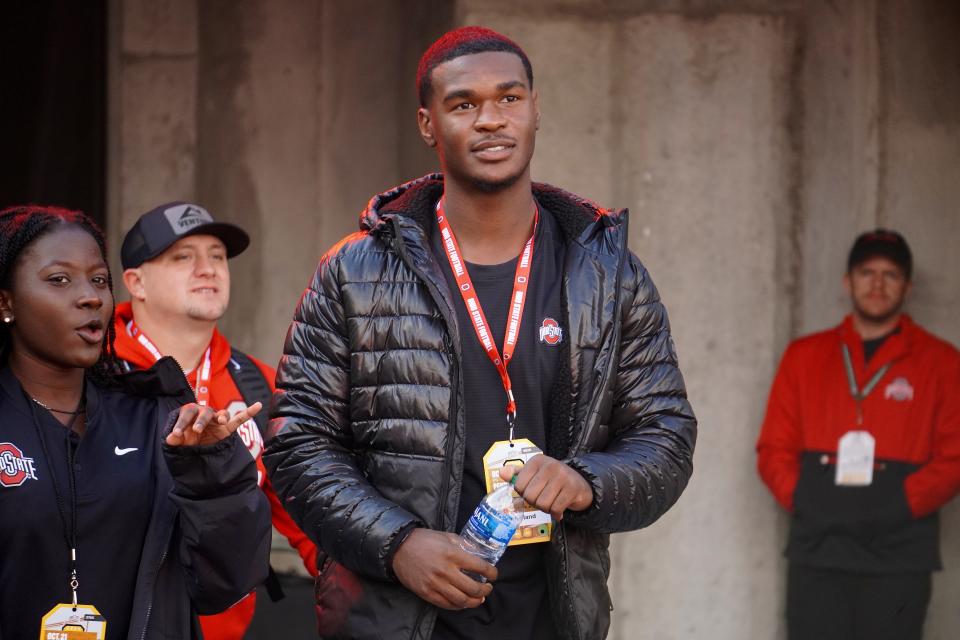Three thoughts on Ohio State football's addition of Kansas State transfer QB Will Howard
Ohio State restocked its quarterback room on Thursday with a commitment from Will Howard, an experienced passer from Kansas State who will join the Buckeyes and be at the forefront of a competition to replace Kyle McCord.
Here are three thoughts on Howard’s transfer:
A starting-caliber transfer was needed
At a news conference on the eve of the Cotton Bowl last week, Buckeyes coach Ryan Day spoke as if Devin Brown was their future at the position.
“As of right now, he’s our quarterback,” Day said, “and we’re moving forward.”

But Brown, who pushed McCord for the starting job as a freshman last offseason, did not have much of a chance to stake a claim in his first start, going down with a high left ankle sprain in the first quarter of the 14-3 loss to Missouri.
The limited audition didn’t help Ohio State get much of an evaluation, but the bigger concern might have been that it was the third time in 2023 that Brown was injured, including fracturing a pinky finger at the end of spring practice and spraining his right ankle against Penn State in October.
If the Buckeyes had eschewed adding a starting-caliber transfer and those durability issues were to persist, the only other options for this year would have been freshmen: Lincoln Kienholz, a redshirt freshman, and Air Noland, a true freshman.

They needed at least a contingency plan and instead found something even better in Howard, a proven commodity who started 27 games at Kansas State and led the Wildcats to the Big 12 title in 2022 over TCU.
Outside of Dillon Gabriel, who left Oklahoma for Oregon, or Riley Leonard, who went from Duke to Notre Dame, it was difficult to find another quarterback in the portal with a track record as extensive.
The addition is a potential stylistic shift
Howard is more of a running threat than the Buckeyes have had at the position in recent seasons.
McCord ran for minus-65 yards last year, and Stroud’s net rushing total over 2022 and 2021 was 88 yards. The passers were largely confined to the pocket.
In four seasons at Kansas State, Howard rushed for 921 yards and 19 touchdowns, promising the most mobility they have had since Justin Fields was behind center at the onset of Day’s tenure.
More: 4 things to know about Ohio State football transfer quarterback Will Howard
More: Join the Ohio State Sports Insider text group with Bill Rabinowitz, Joey Kaufman Adam Jardy
There are some potential drawbacks to Howard as a passer. Last season was his first in which he had a completion percentage above 60% and his 2.8% interception rate was a bit higher than McCord’s 1.7% mark. On deep balls, as measured by Pro Football Focus as passes traveling 20 or more yards in the air, he completed just under a third of them, whereas McCord and Stroud completed at least 50%.
But his legs provide the Buckeyes with intriguing upside and an element they seemed to be searching for last fall when they began rotating Brown for McCord in short-yardage situations, an attempt to use an athletic quarterback to equate numbers when defenses load the box.
Both of Ohio State’s third- and fourth-down conversion percentages dipped last year.
If Howard ascends to the top of the depth chart, it will be interesting to see how Day ultimately tailors his scheme to fit a different skill set.
His size at 6-foot-5 and 242 pounds also makes him a potentially effective piece in option plays if Day calls for more zone reads from his quarterback. Fields averaged as many as 10 carries per game for the Buckeyes in 2020, including sacks and scrambles.

Quarterback upheaval is not guaranteed
Betting against movement at any position is unwise in this era of college football, especially at quarterback.
But the room should be intact through spring practice.
That’s because the first of two offseason transfer portal windows closed Tuesday. It won’t be until the end of April before the second one opens.
That leaves the Buckeyes with at least three months to convince Brown, as well as Kienholz and Noland, to remain in the fold for the year.
It wouldn’t seem that hard of a sell even if preaching patience comes with challenges.
Howard has only a year of eligibility left, and if he indeed takes over as Ohio State’s starting quarterback, it will require them to sit for only one season before another competition resumes. The situation likely makes Howard a bridge to the future.

Had the Buckeyes targeted UCLA’s Dante Moore or Liberty’s Kaidon Salter, quarterbacks with multiple seasons of eligibility remaining, the staff’s conversations with its returners would have been more difficult and added more complications to any succession planning.
Even if Brown, the Buckeyes’ most tenured passer, remains on the roster remains as the backup for another year, he would be eligible to start in 2025 and 2026.
A quarterback rental gives Ohio State a chance to thread a needle on adding another arm while trying to maintain continuity.
Joey Kaufman covers Ohio State football for The Columbus Dispatch and can be reached at jkaufman@dispatch.com.
Get more Ohio State football news by listening to our podcasts
This article originally appeared on The Columbus Dispatch: Will Howard to transfer to Ohio State: 3 thoughts on QB addition
